Slope and Intercept Practice Poof Book
This blog post contains Amazon affiliate links. As an Amazon Associate, I earn a small commission from qualifying purchases.
I want to share a downloadable template I created for a slope and intercept practice poof book. I made it to give my students practice finding the slope and intercepts of a line that goes through two given points.
I think I’ve done a better job this year of introducing x- and y-intercepts in Algebra 1 than last year.
I led up to the concept by asking students what the word intercept reminded them of. Where two roads cross. Football. There was another answer, but I can’t remember it right now. Then, I drew a coordinate plane on the Smart Board. I asked students for points that would lie on the x-axis. (3, 0). (5, 0). (-1, 0). (52, 0). (79, 0). What do these points all have in common? The second number is always zero. What do we call that second number? Y. Yes, the y-coordinate is always zero if a point is on the x-axis. We repeated the process with naming points on the y-axis.
Next, it was time to take notes in our interactive notebooks. To save a little time, I wrote out the definitions, leaving blanks for my students to fill in. We repeated the same process for y-intercepts.
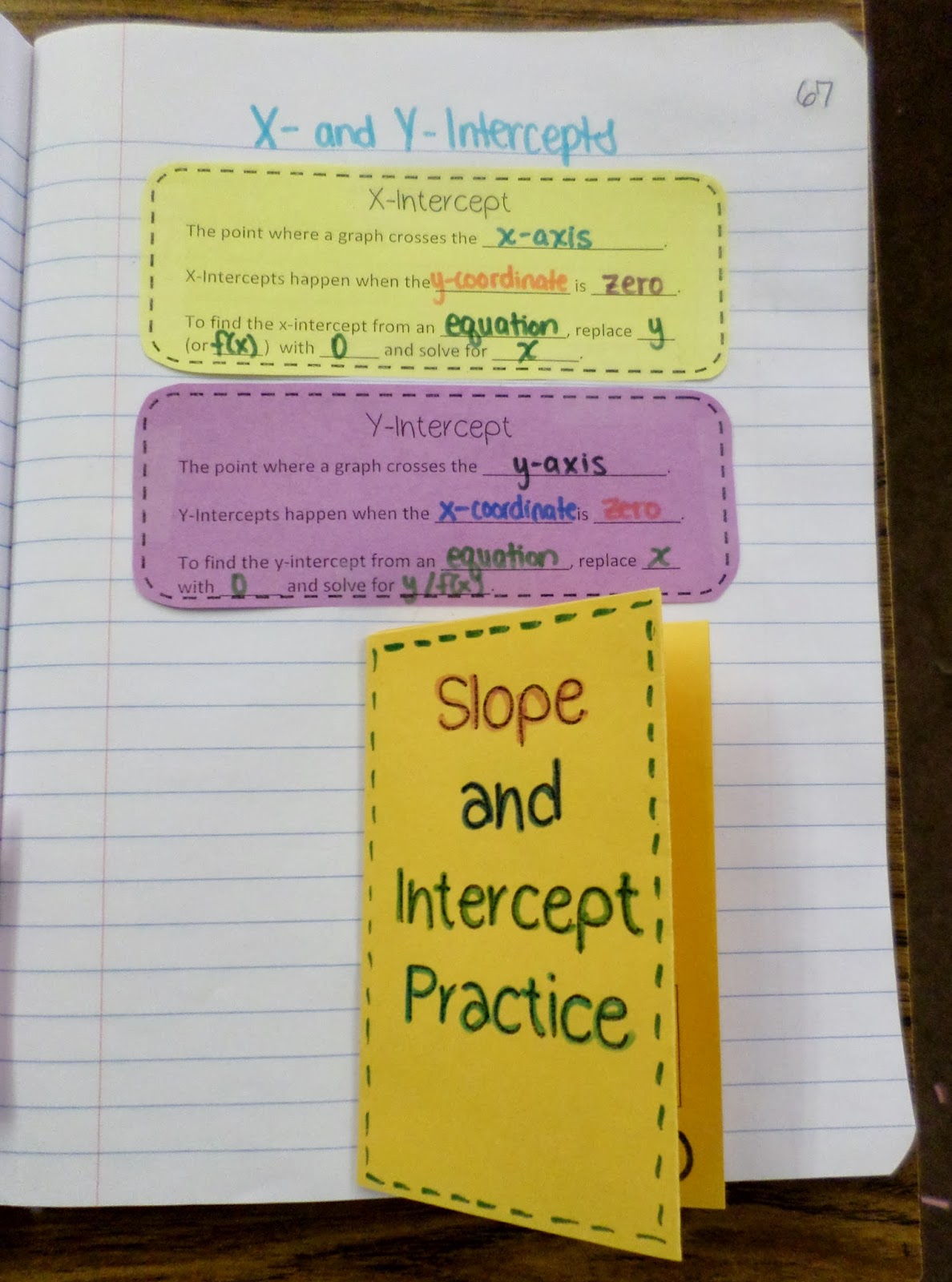
Next, we made a poof booklet to practice finding the slope, x-intercept, and y-intercept of a line. This is our second poof book of the year. The first poof book we made was for exponent rules. A poof book is made out of a single sheet of letter-sized paper. I have linked to the file to make this booklet at the bottom of this post.
How to Assemble a Poof Book
Here are step-by-step pictures on how to assemble the book:
Here’s what the template looks like to begin with.
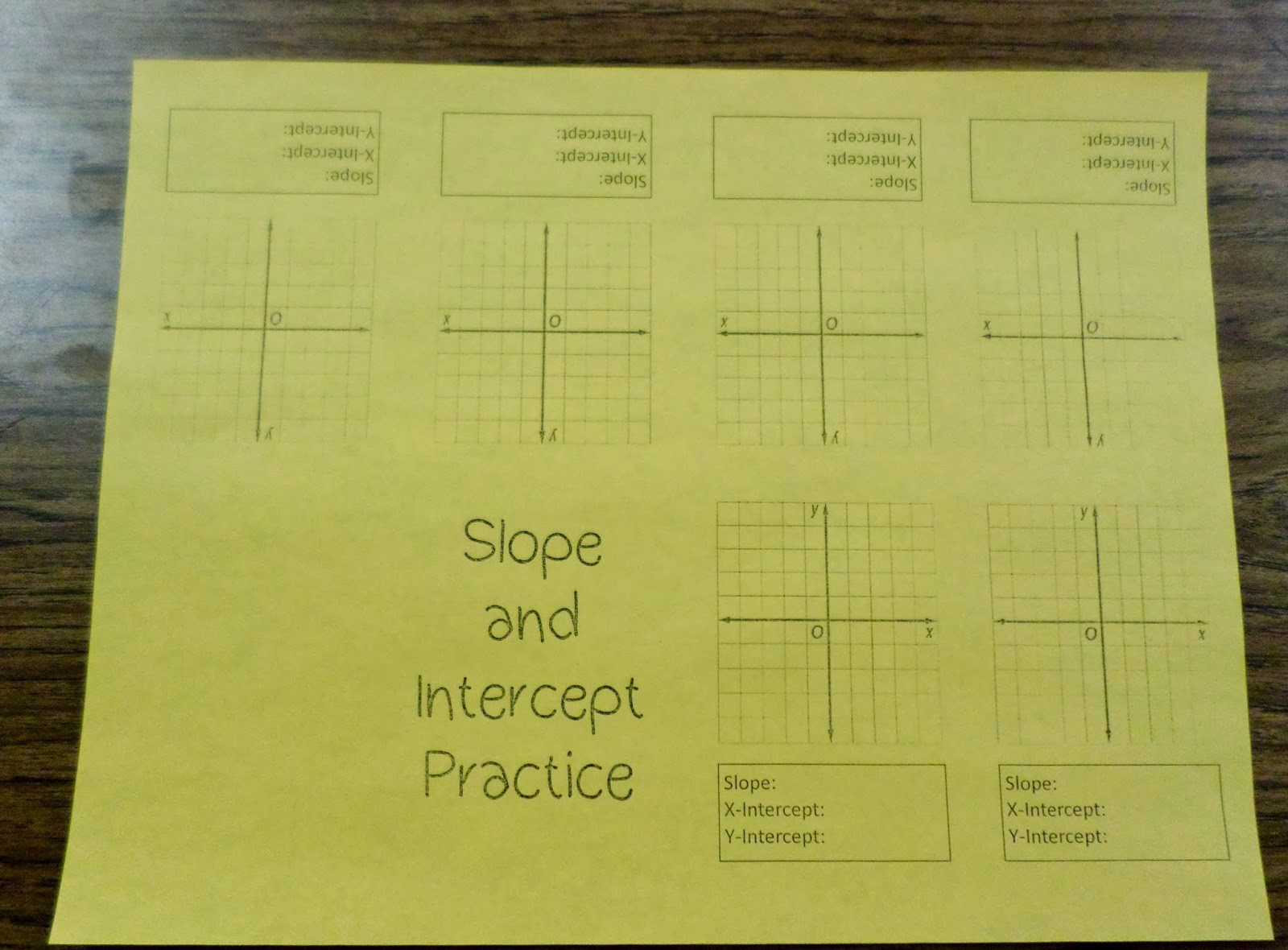
Fold the template in half, hot dog style. The graphs should be on the outside.

Fold in half again, so the front and back covers are showing.
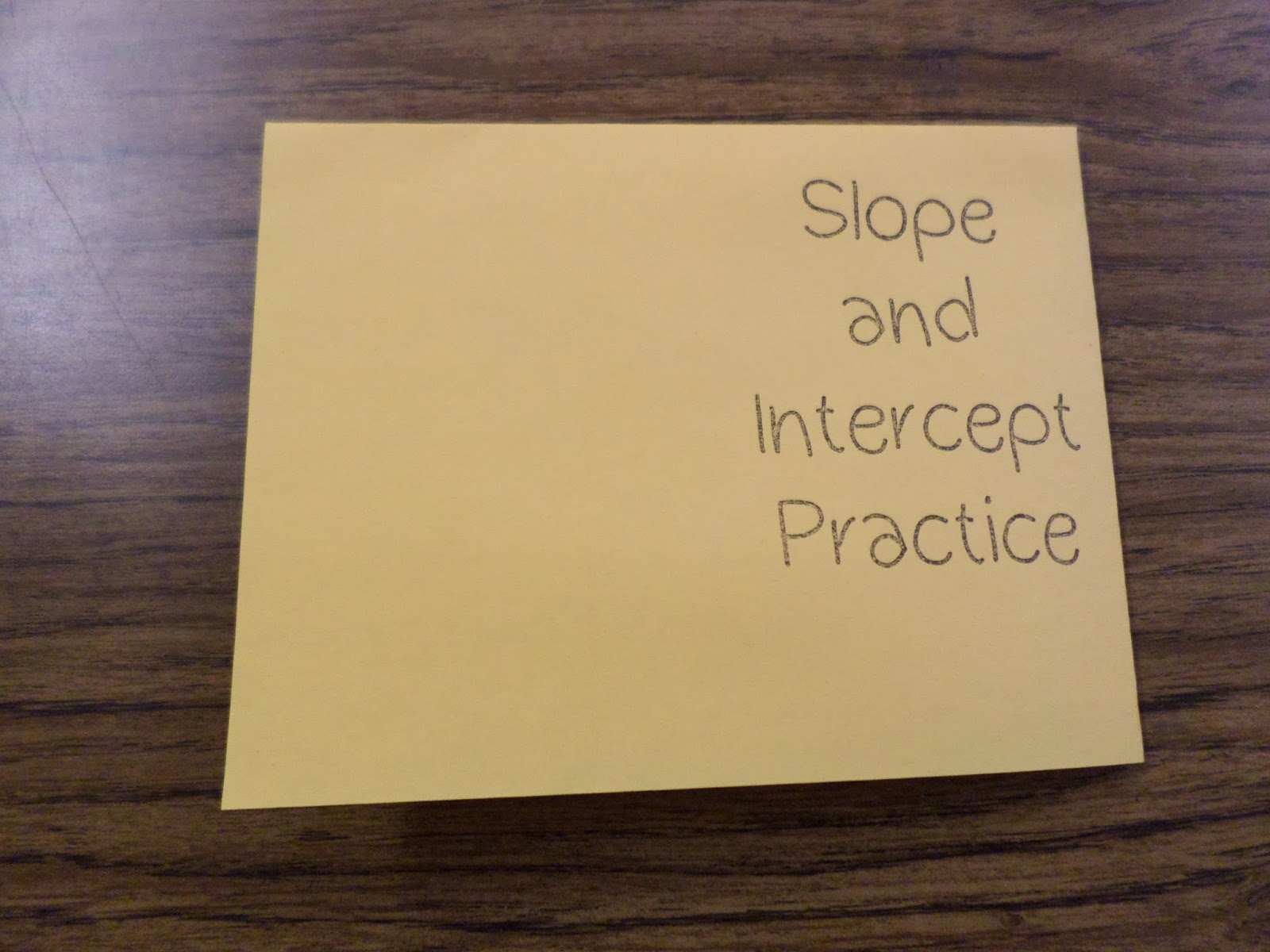
Fold in half one more time. The front cover of your booklet should say “Slope and Intercept Practice.” It should look like a mini-book. We’re not done yet, though.
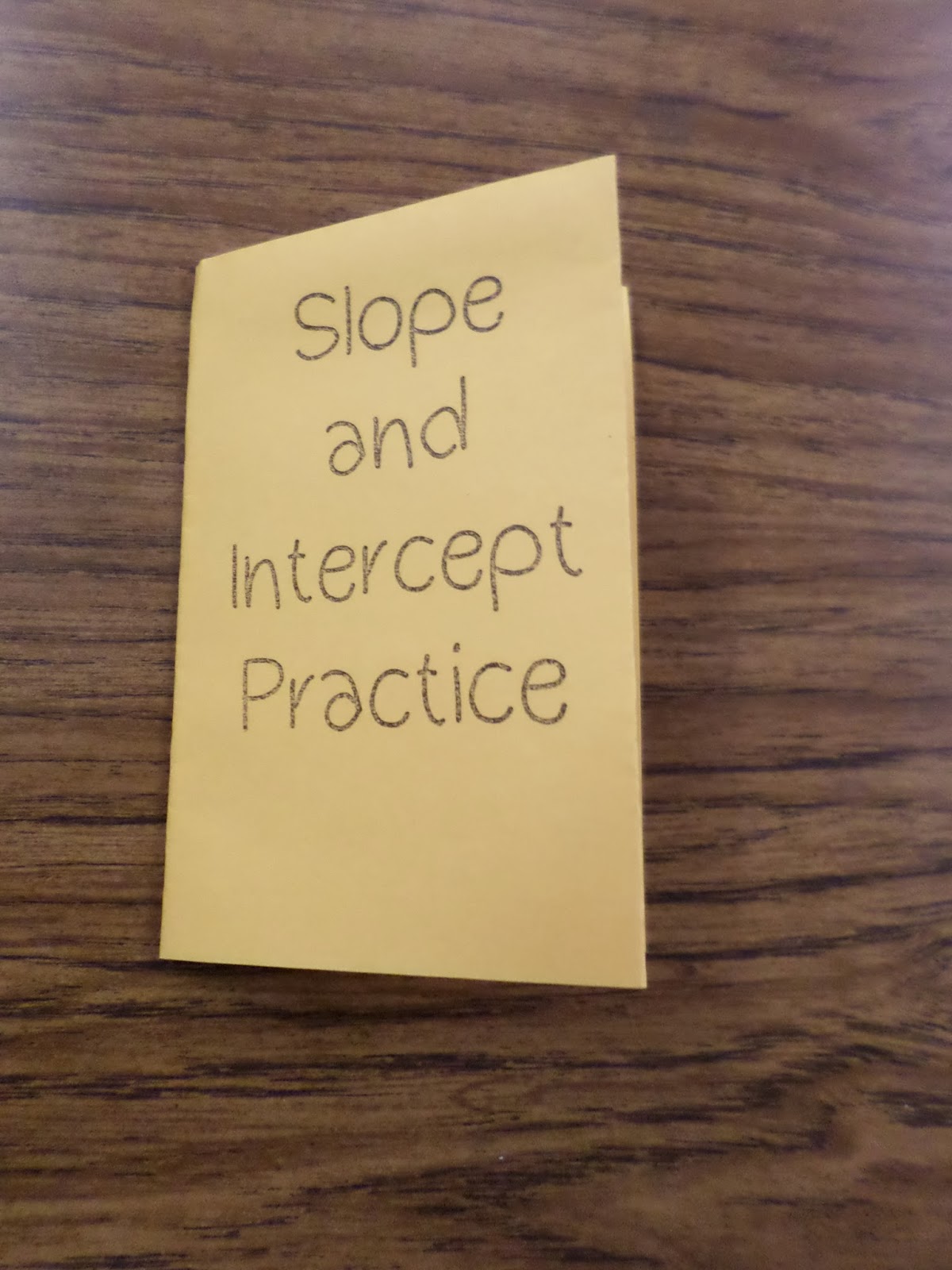
Unfold your booklet. It should be creased like this:
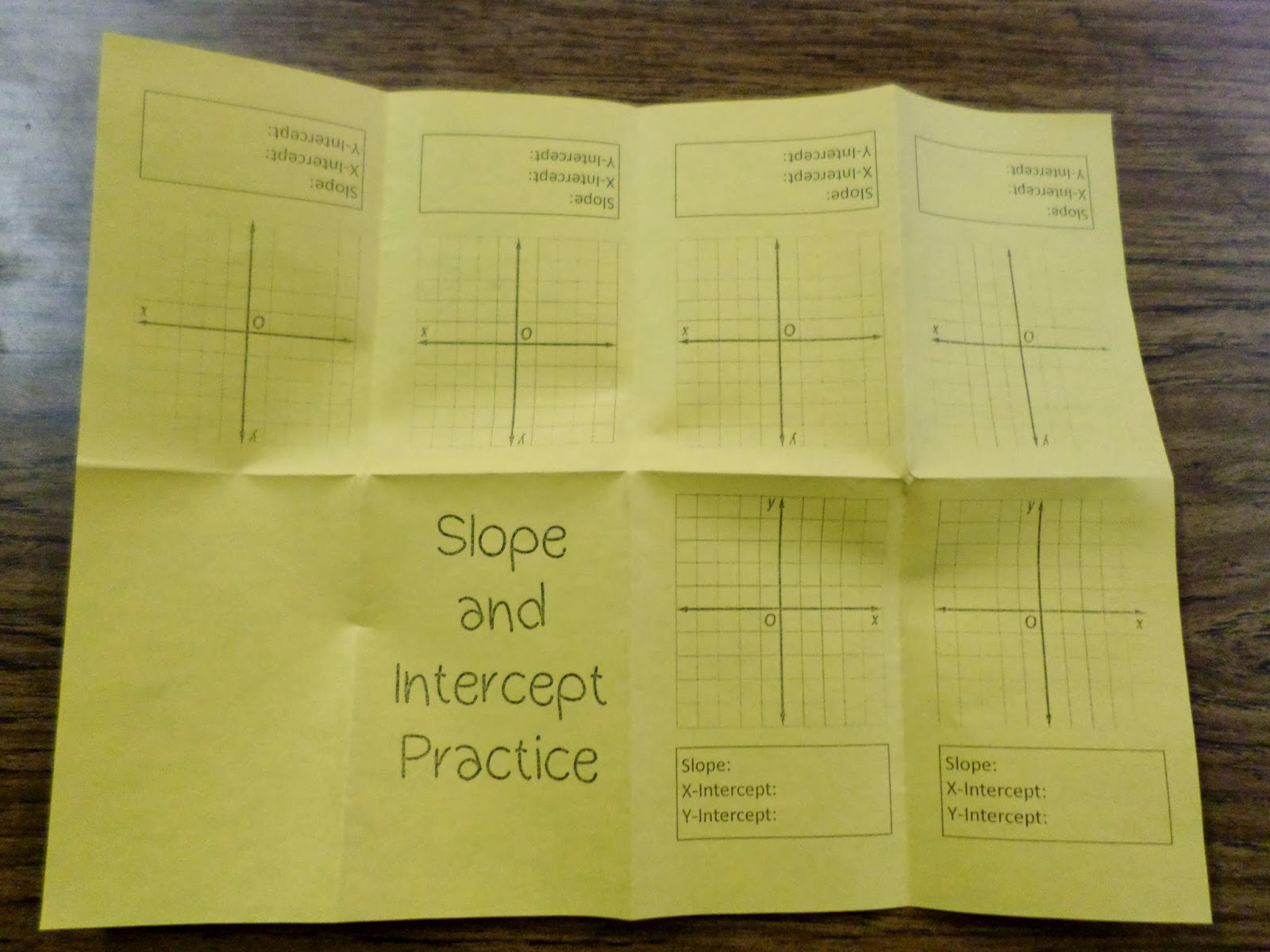
This time, fold the paper in half, hamburger style. Some of my students insist on calling this taco style because hamburger buns aren’t joined on one edge.
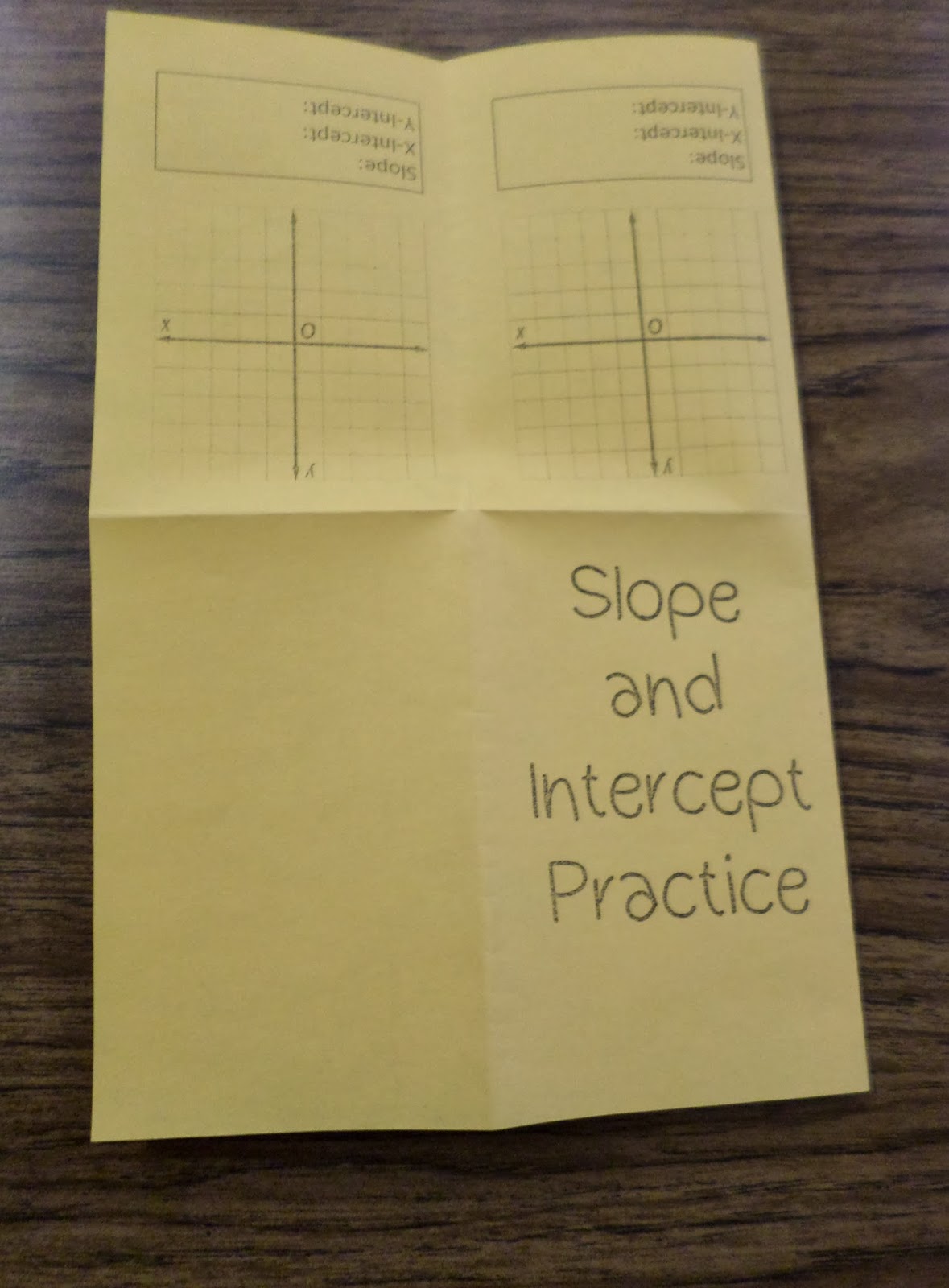
Take your scissors and cut through the fold above the front cover to the crease. Do not cut past the crease or you will end up with two pieces of paper instead of one. Yes, I’ve had students do this.
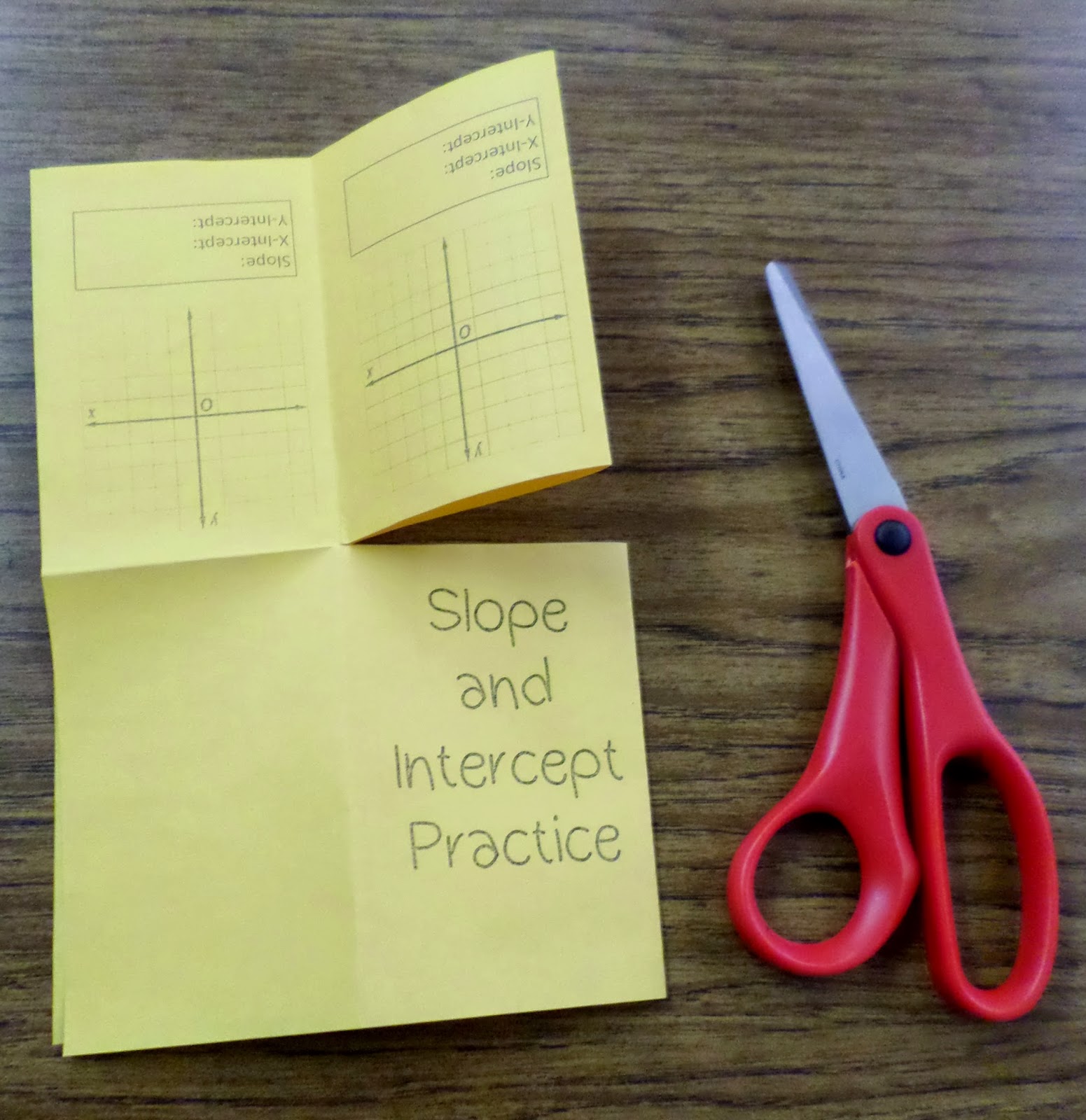
Unfold the paper, and refold it hot dog style. You should notice that the middle starts to “poof” open. This is good!
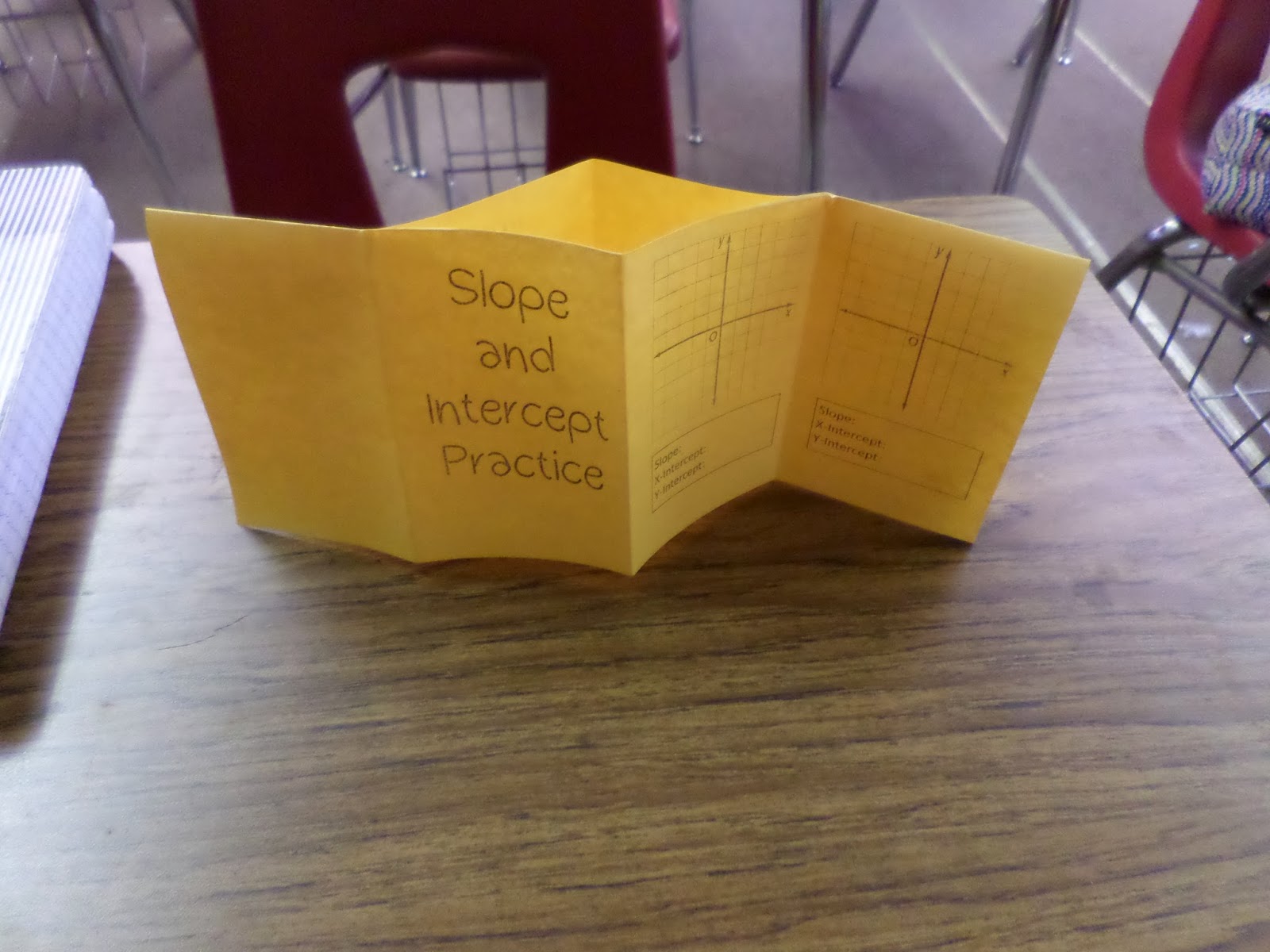
This is the hardest part for my students. We want to open up the “poof” and collapse it so it forms the pages of our book.

Now, we have a cute little book that not only looks like a book but opens like a book!
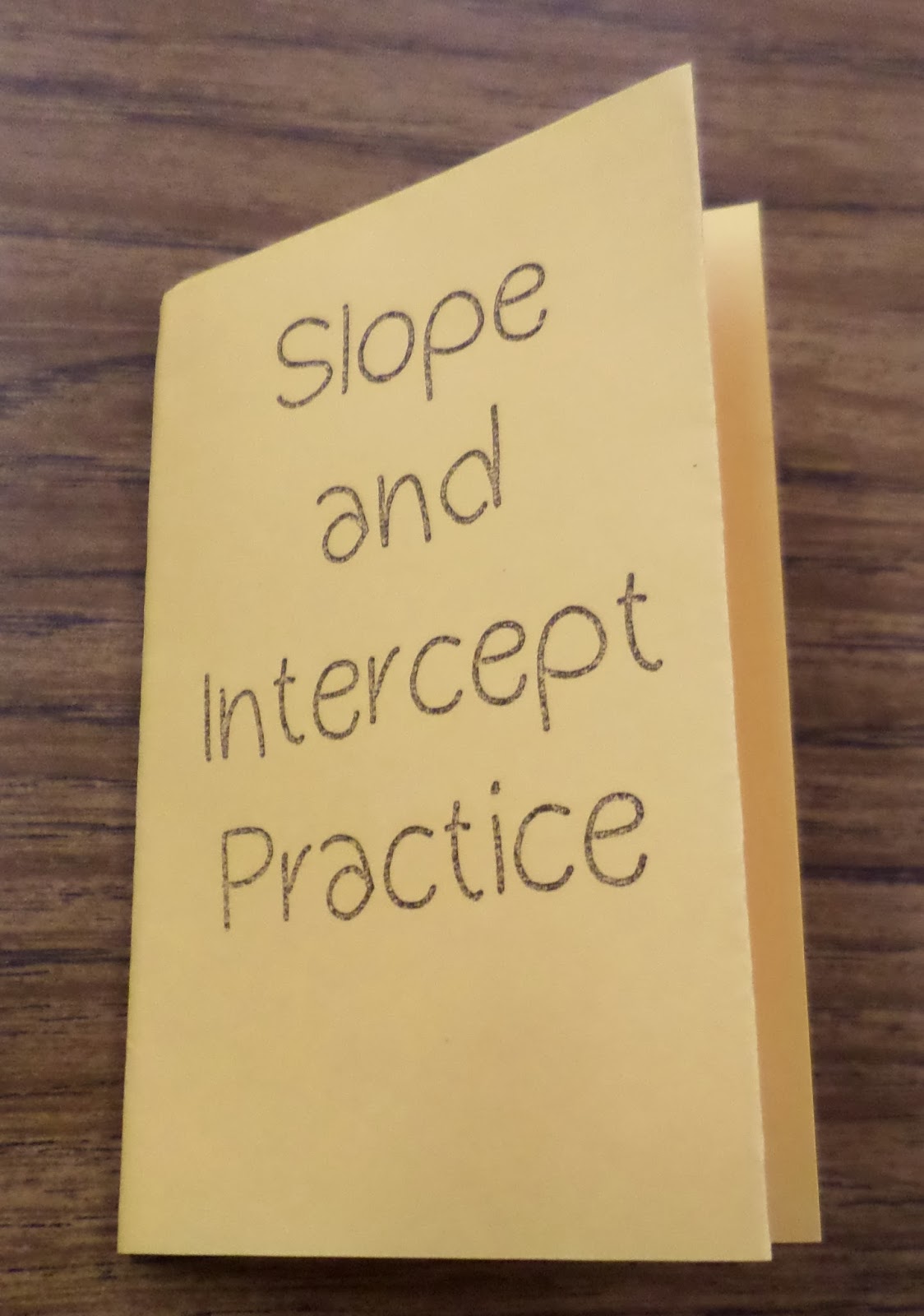
Here is what the first two pages on the inside of the book look like:
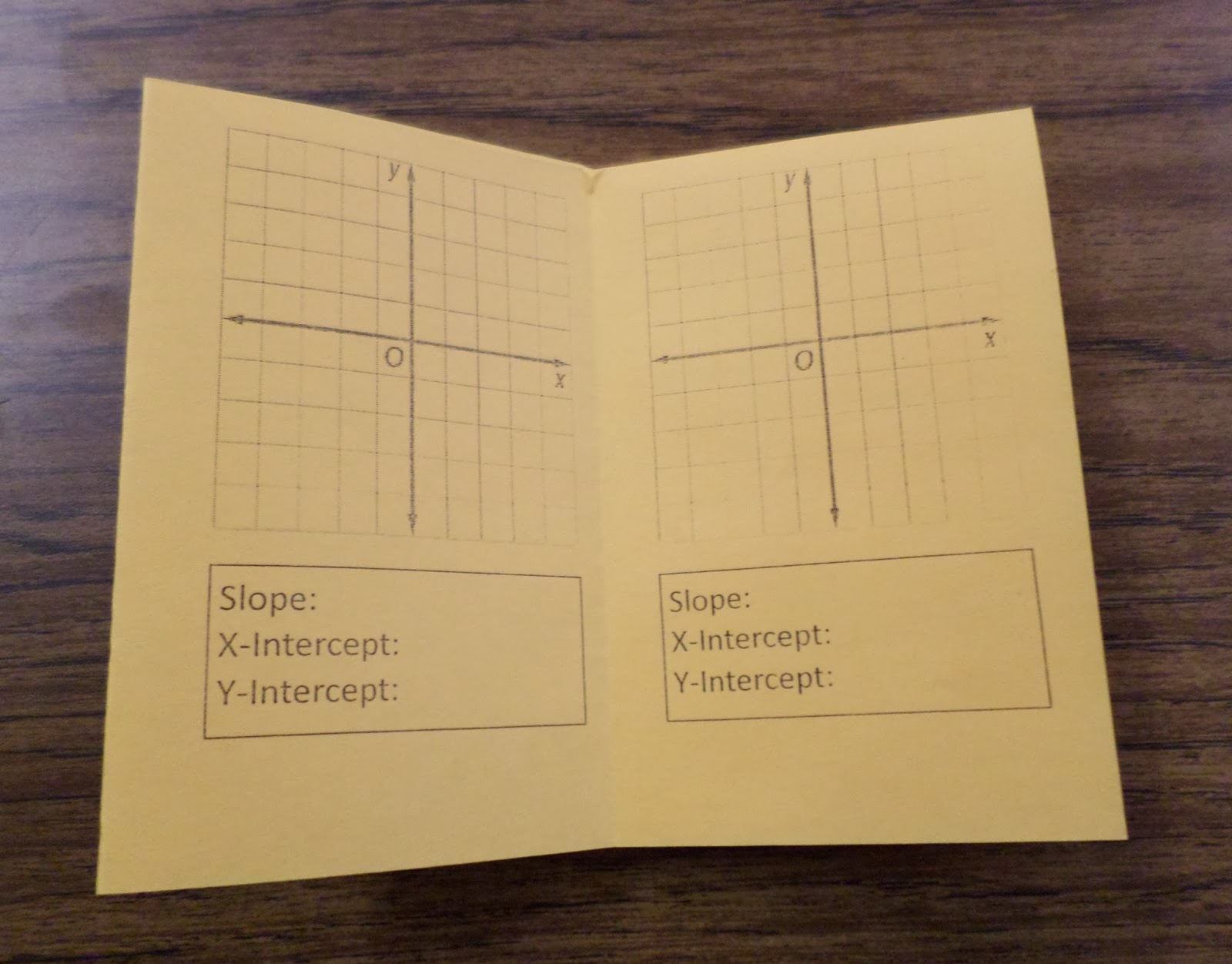
I gave students a pair of ordered pairs to graph on each page. Students were tasked with graphing the points, determining the slope of the line, determining the x-intercept of the line, and determining the y-intercept of the line. After doing this with my first period, I learned the importance of using a ruler to connect the two ordered pairs. I specifically picked ordered pairs that would produce a line that had x- and y-intercepts that were integers. But, if the line is not drawn perfectly straight, it often looks like it crosses between two integers.
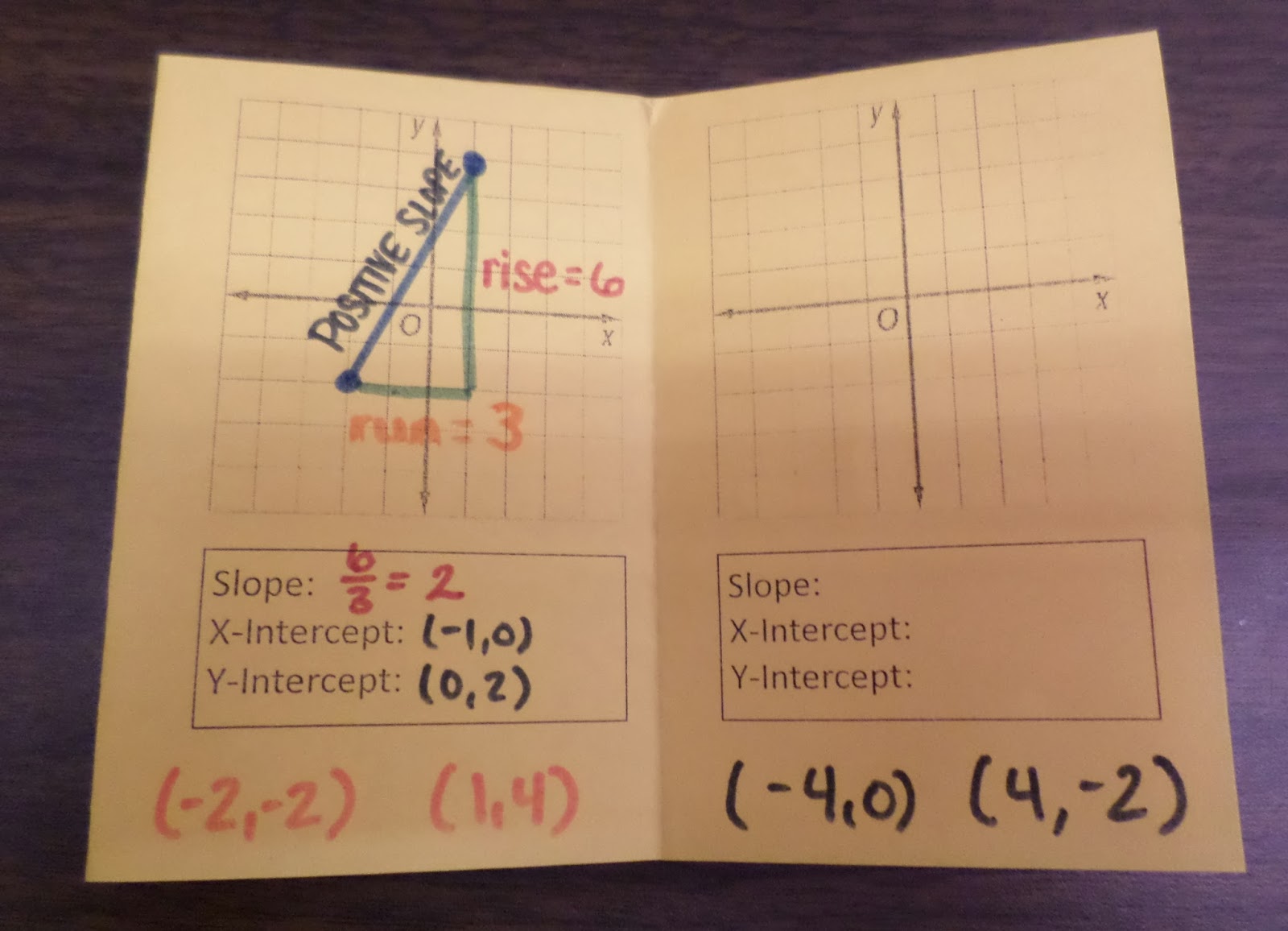
I projected the pairs of ordered pairs on the board for students to copy down.
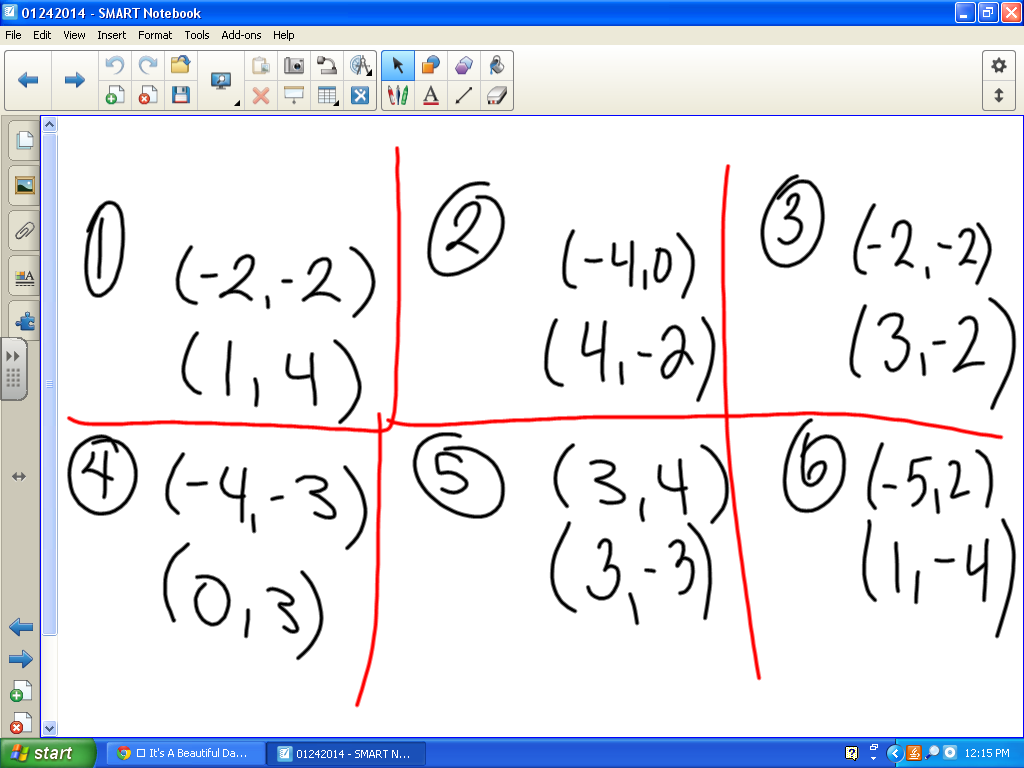
Here’s what the poor book looks like when glued in our interactive notebooks. Students were required to finish the booklet as their homework assignment. I like that this can be kept in their notebooks and referenced in the future. The same cannot be said about most of the homework assignments I give.
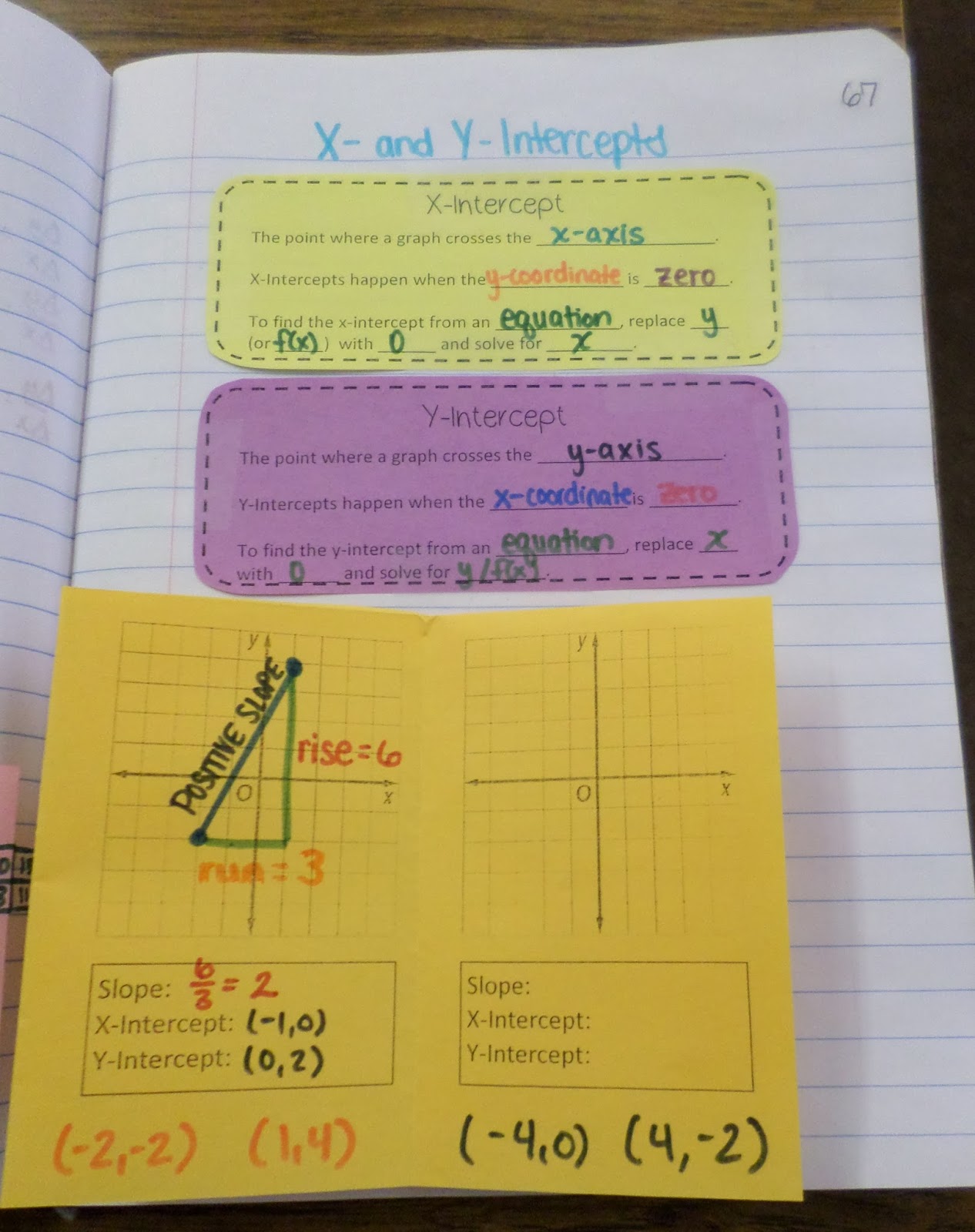
Final Product:
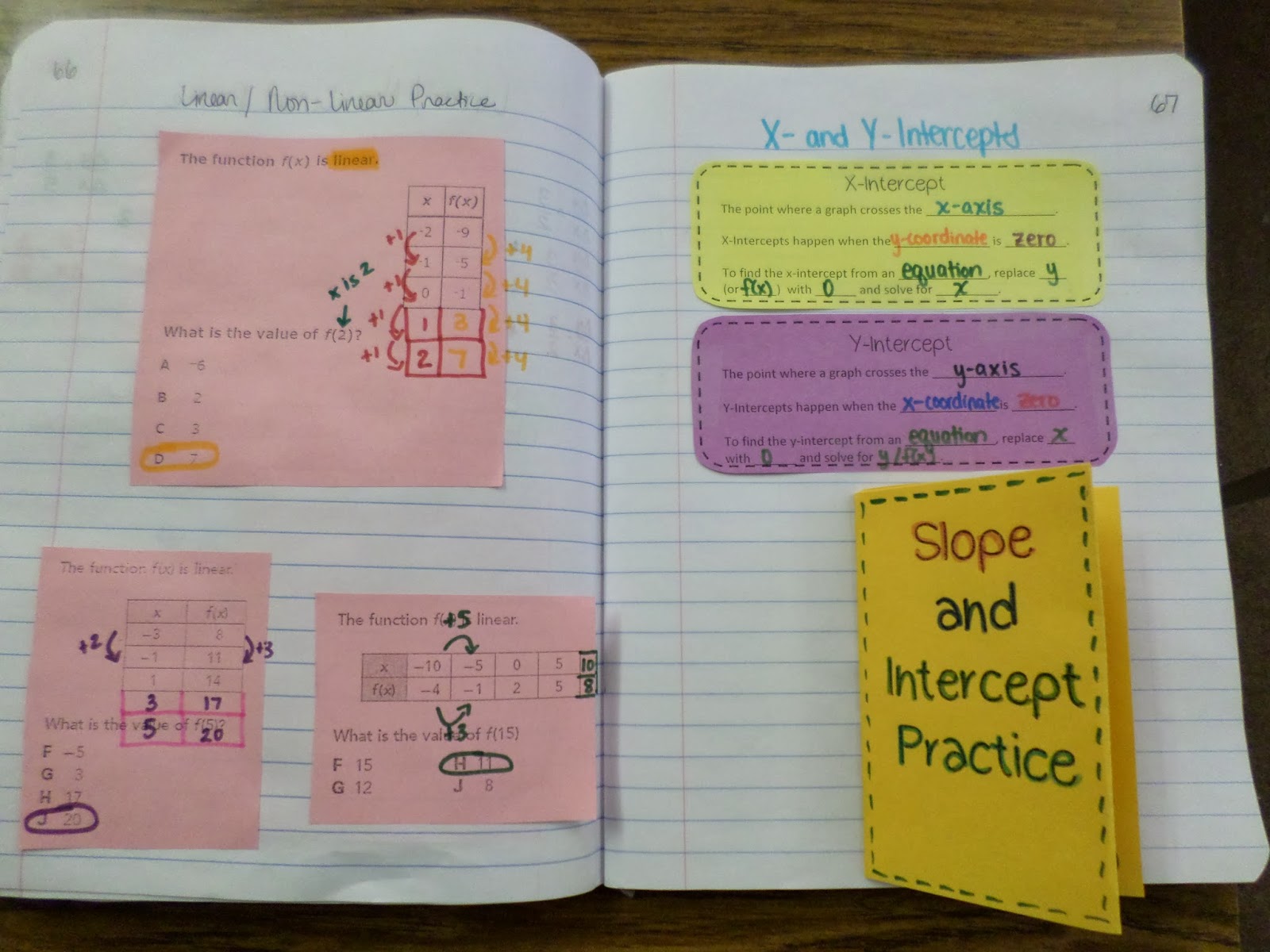
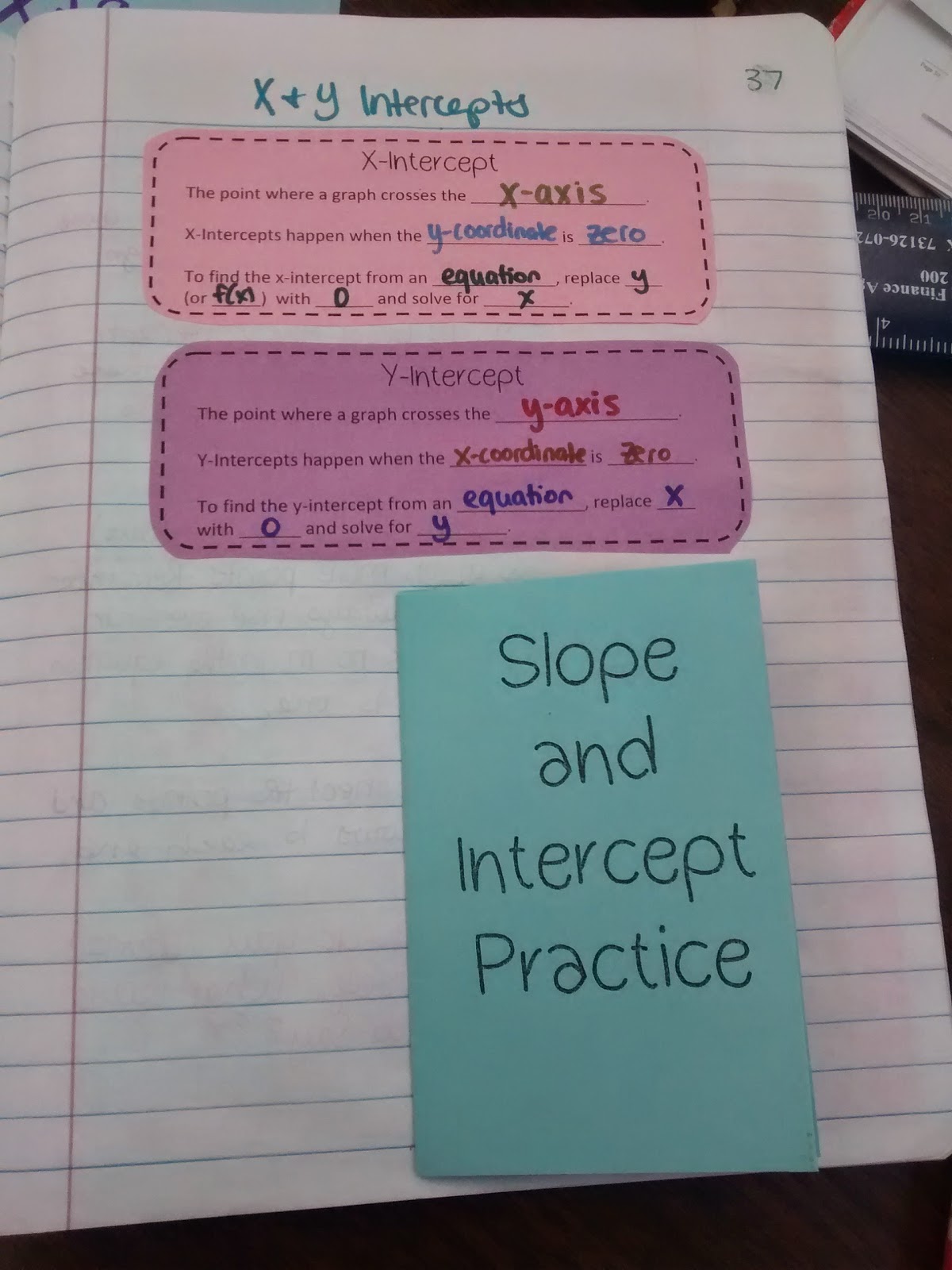
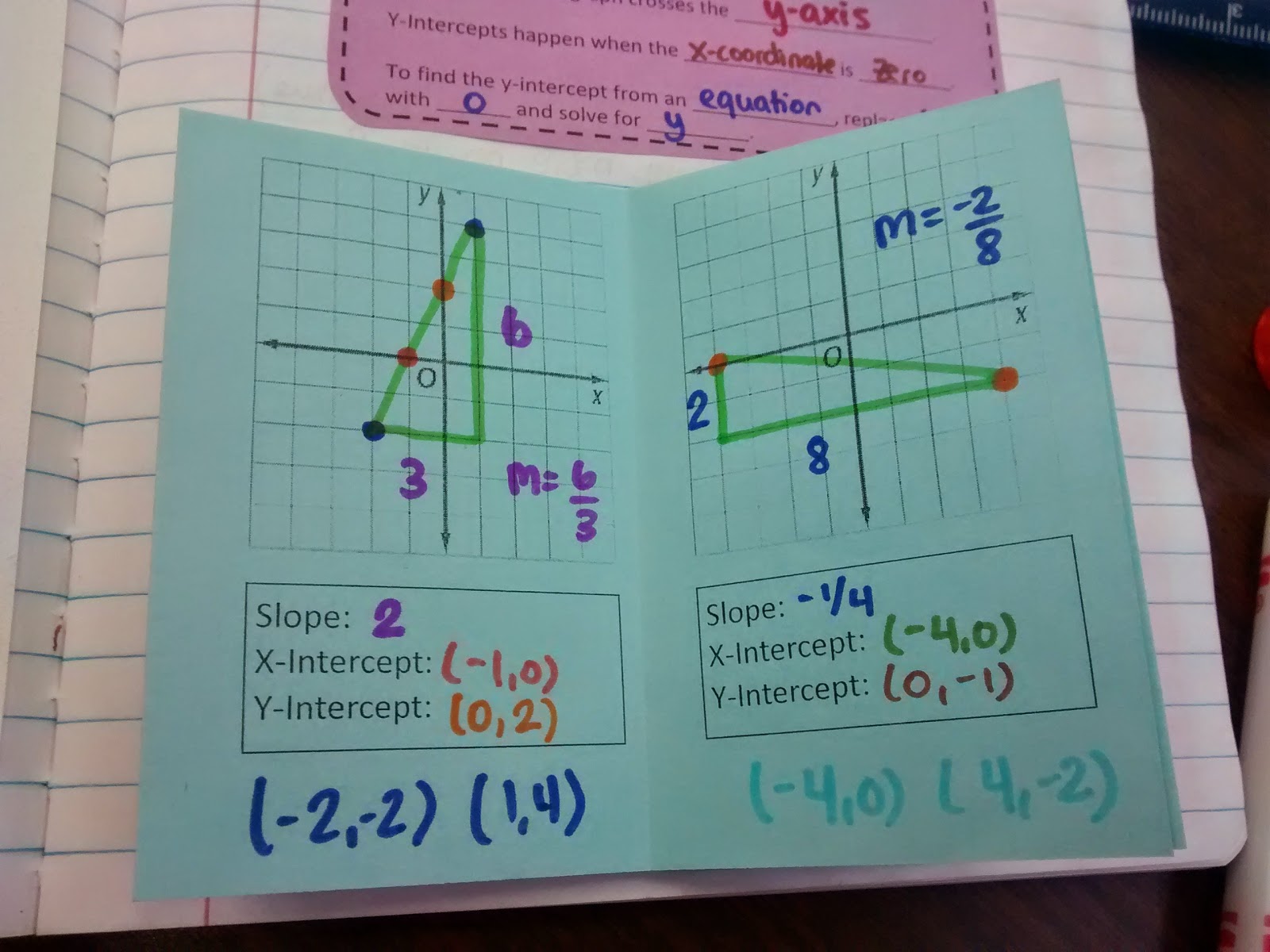
Free Download of Slope and Intercept Practice Poof Book
Click here to Download
X-Intercept Notes (PDF)
1579 downloads – 67.37 KB
Click here to Download
X-Intercept Notes (Editable Publisher File ZIP)
1402 downloads – 68.81 KB
Click here to Download
Y-Intercept Notes (PDF)
1578 downloads – 66.36 KB
Click here to Download
Y-Intercept Notes (Editable Publisher File ZIP)
1297 downloads – 67.16 KB
Click here to Download
Slope and Intercept Practice Poof Book (PDF)
1782 downloads – 83.40 KB

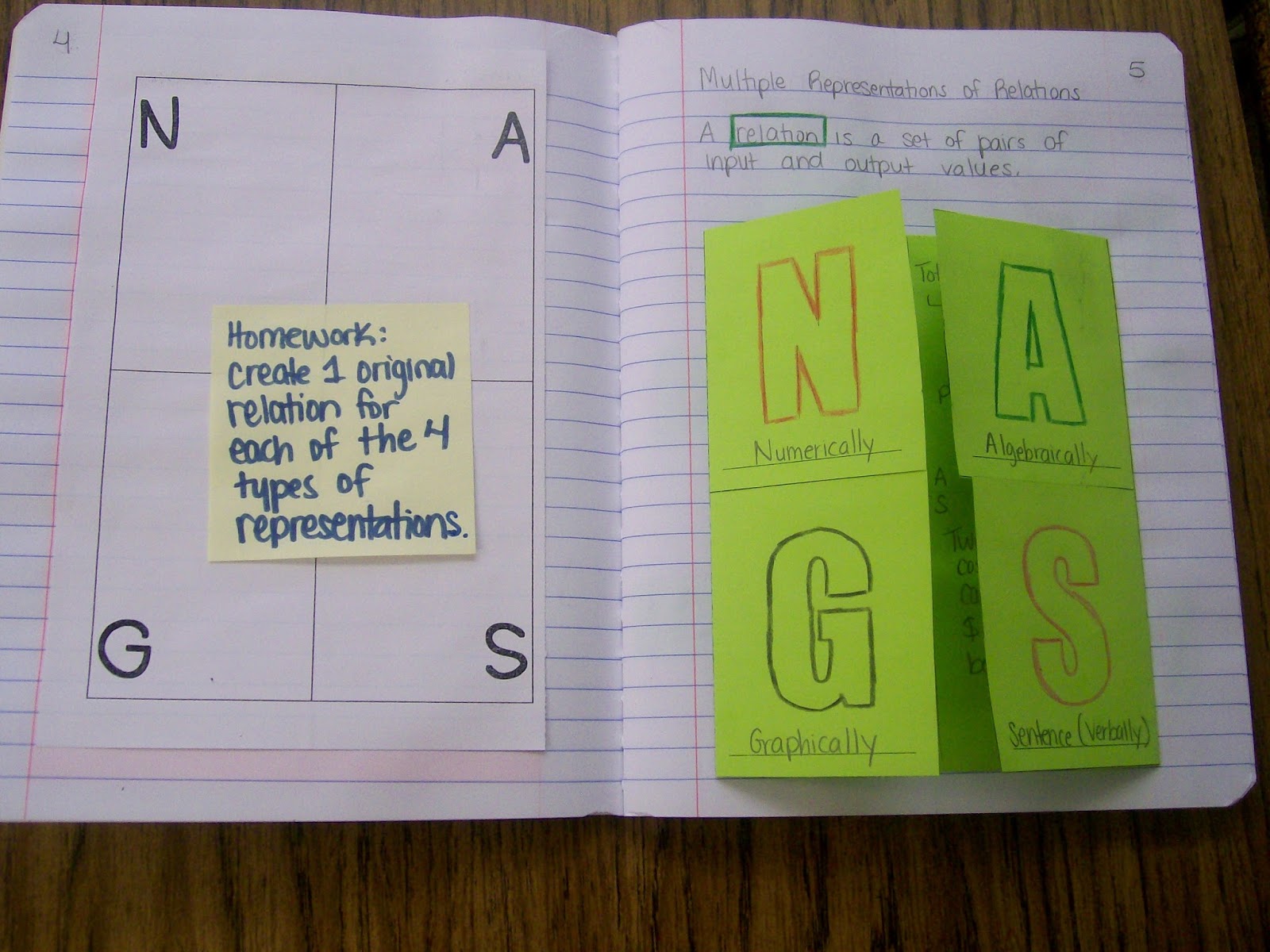
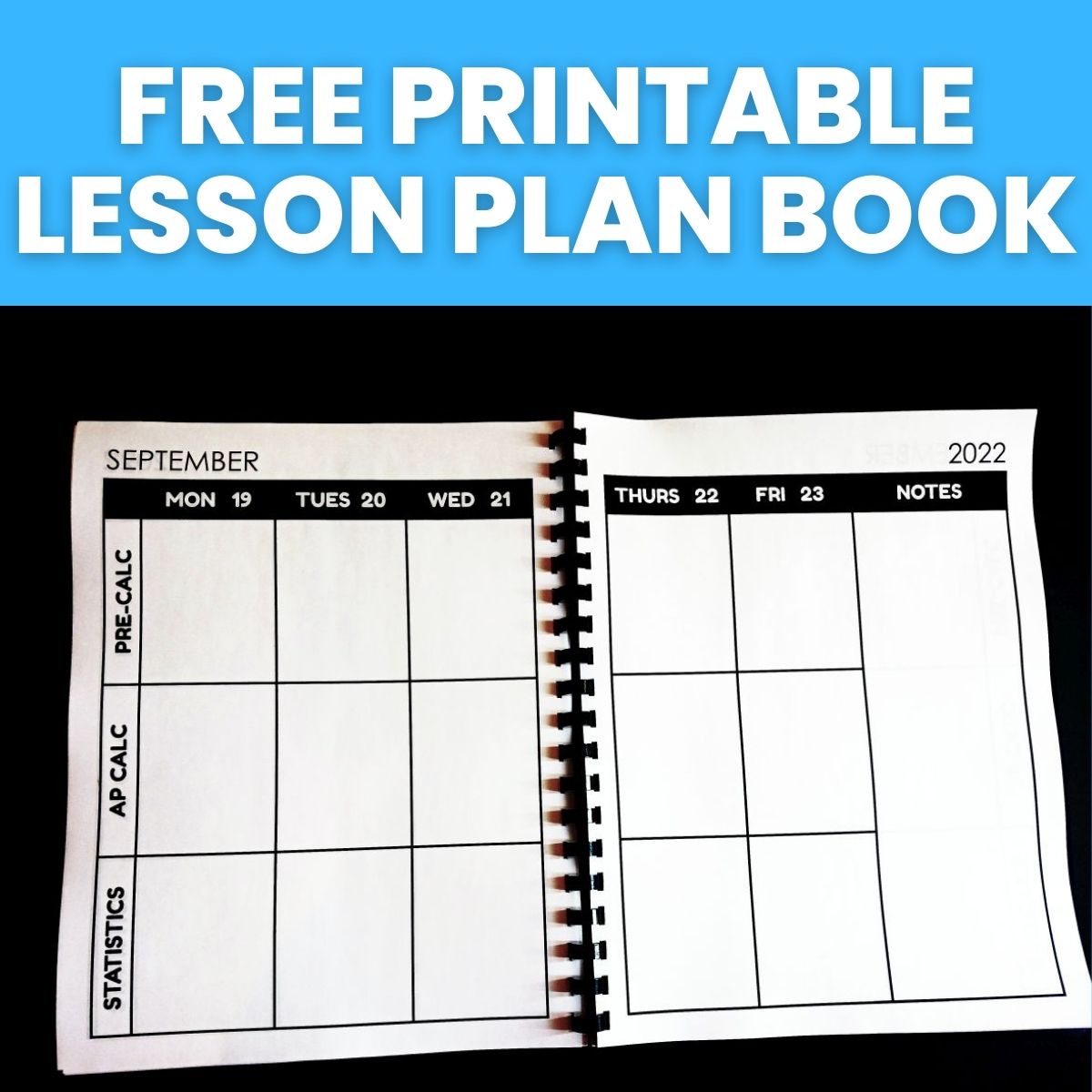
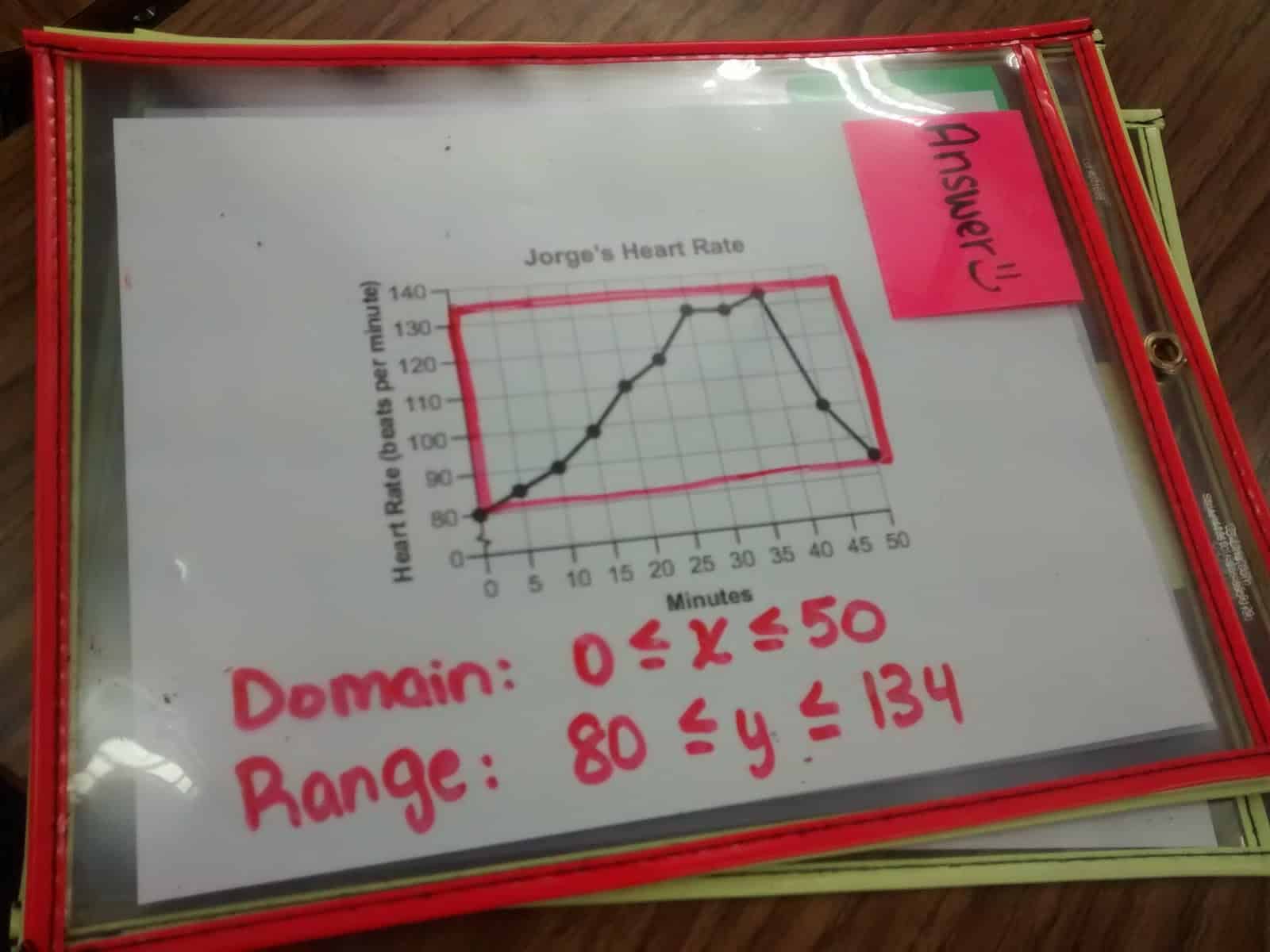
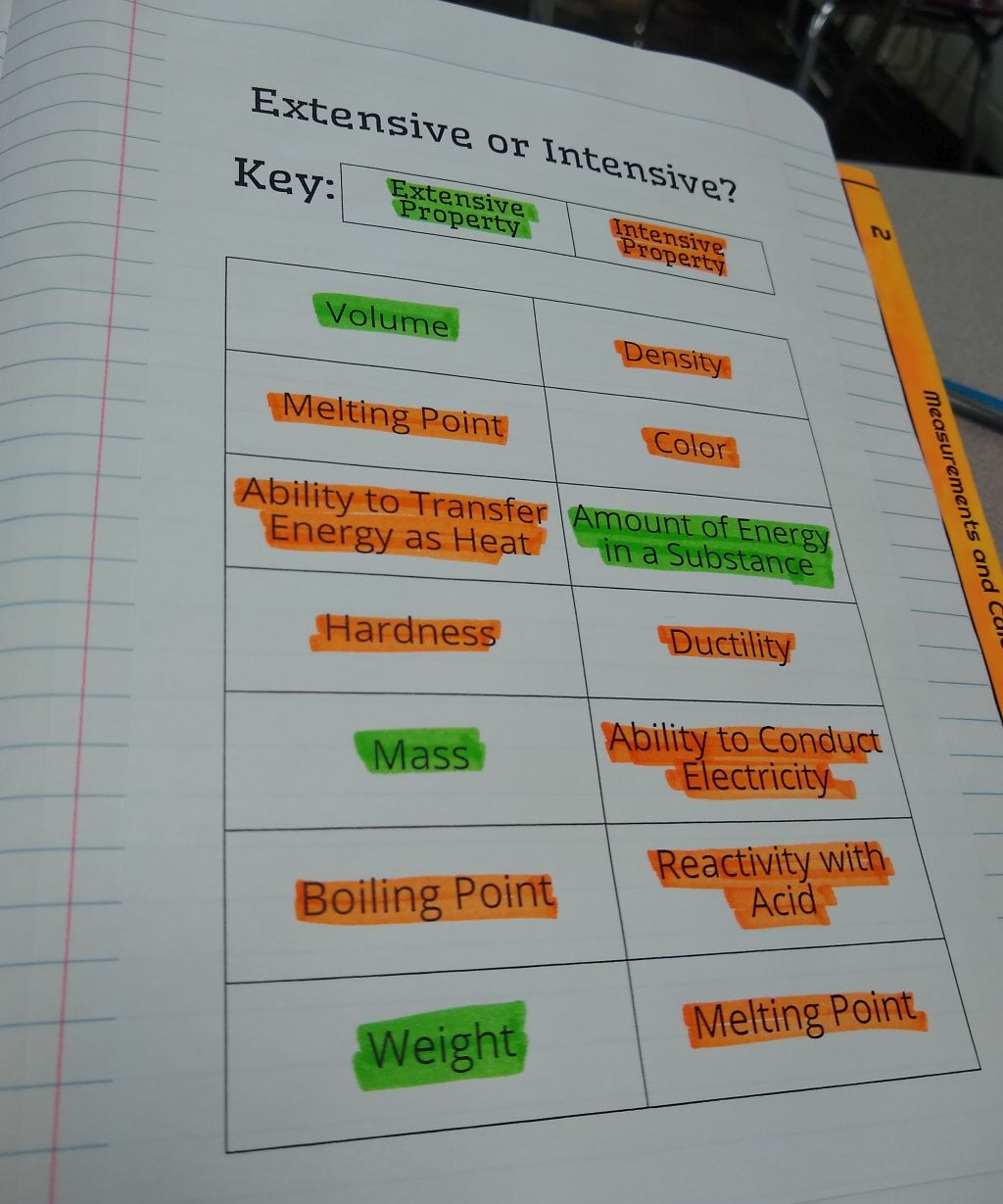
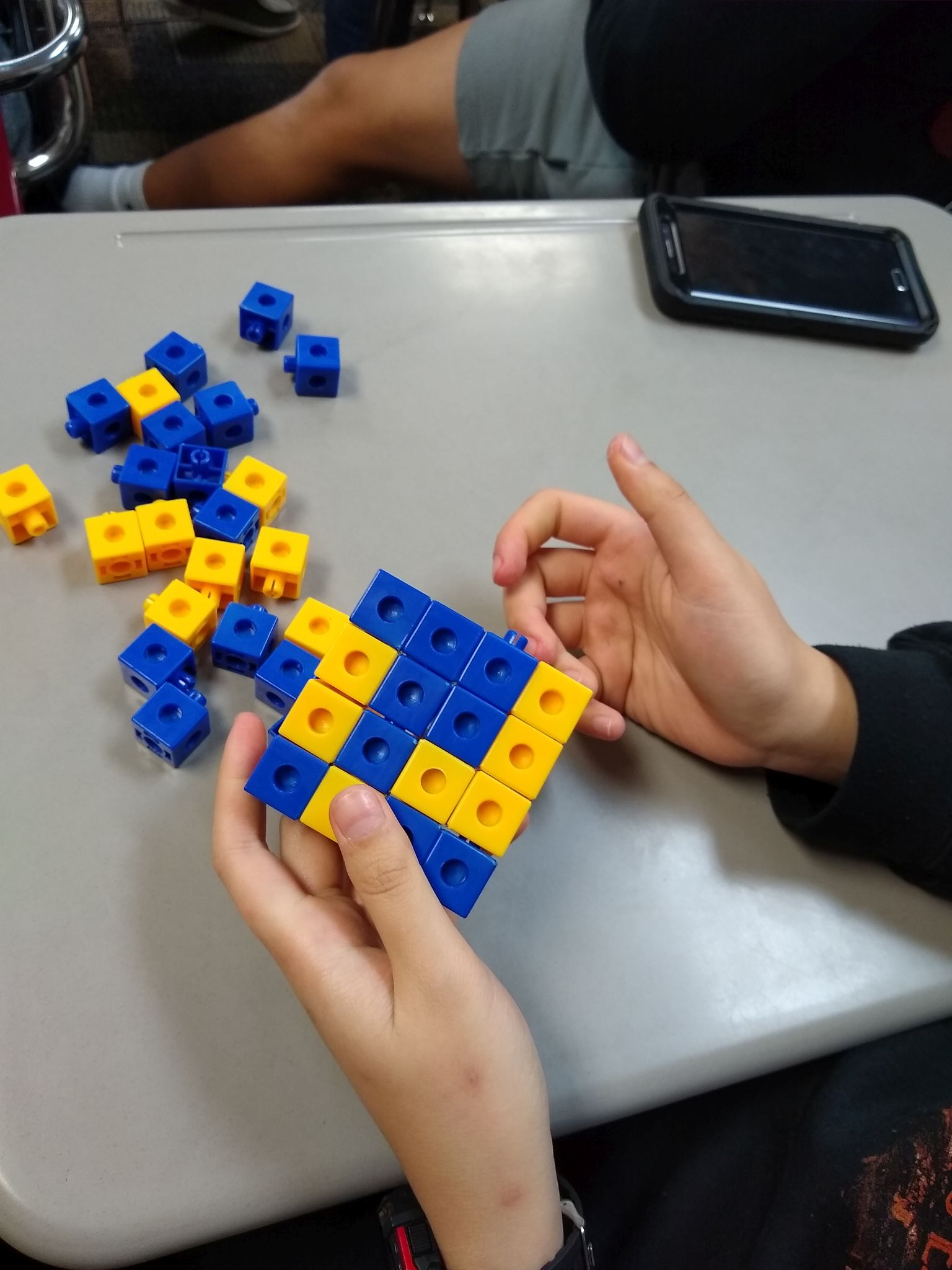

Great ideas love your blog! Thanks for always sharing.
You're welcome! Thanks for reading my blog!
Thank you for showing how to create that little booklet! I have seen those before, but wasn't sure how to make it. So cute and perfect size pages for individual problems! 🙂
I agree! It's a way to fit a page of practice into their notebooks without taking up a whole page in their notebooks. I LOVE watching my kids' faces when they make these books for the first time. Their expressions do not disappoint!
I can't wait to make this with my classes. I took your advice and decided to tackle all of the polynomials before slope this year. Phew! Needless to say, we haven't started on graphing or slope yet. But let me add that my students only get 3 hours a math instruction a week so we are behind from the get go!
Glad you like it! I'd be interested to hear more about what you think of tackling polynomials before linear functions. I'm still glad I did it with my students this year. Part of me says I'm way behind, but another part of me says I'm right where I should be. I need to do some more research regarding Common Core so I can decide what order I want to approach things next year.
It's always great to connect with another Oklahoma teacher!
Thanks so much for posting these, especially the editable publisher files. Question for you about how you manage homework with INBs: do students do their assignment in their INB or on loose leaf paper? If it's on separate paper, where do they store it? Do they have another folder?
I'm glad to hear somebody has found my publisher files to be useful! I'm trying to go back and update all my posts to include the editable files. It's going to take me a while…
Most of my assignments are worksheets. We don't have textbooks, so I don't have much of an option. This is bad, but I've never made my students keep their assignments. I know I should. I just haven't wanted to deal with the hassle of it. Eventually, I want to make it where all of their assignments are kept in the interactive notebook. Maybe next year we will make a pocket for each chapter. And, students will be required to keep that chapter's assignments in that pocket.
I do have a few students who keep a pocket folder with all of their graded work. But, most of my students look at the grade and then recycle it.
Thank you for sharing. I enjoy reading and seeing your ideas. They inspire me.
You're welcome! Thanks for reading my blog!
It's my first year teaching 8th grade math, and your blog is a gold mine!! Thank you for sharing!!
You're welcome! I'm glad you've found my blog to be of use!
You do fabulous things in the classroom! Thank you so much for sharing all your ideas, hints, helps, and experiences! KS Mathgal
I have made mini books before (i think you call it a proof book), and we always printed, cut and taped them. I love that you used publisher. I am a bit of a computer nerd, but did not even think to use publisher…lol. Thanks!
After reading a few math blogs, I am tempted to make one of my own, but I really don't know if I have the time or if my "stuff" would be good enough.
P.S.
Thanks for all the free files!!
Something to add to your arsenal…Dinah Zike…
https://www.amazon.com/Notebook-Foldables-Spirals-Binders-Composition/dp/1882796276
I just bought this book and found that it is just like her foldables but saves paper, it also has some other/new useful techniques to add to your notebooking.
Hope you find it helpful.
Poof books are super cool! I've used them with two of my classes-one of them was your exponent rules book-and they loved them! Some of them had slight difficulty with where to cut and how to turn it into a book, and I thought this video illustrated it nicely. Thanks again for always sharing!
https://www.youtube.com/watch?v=KyBvLycibe4&safe=active
Thanks for the link! I think showing this to my students would definitely clear up the inevitable misconceptions of where to cut!
You are amazing THANK YOU!!!!!!!!!!!
You're very welcome!
This is amazing for people who struggle with algebra, thank you so much.